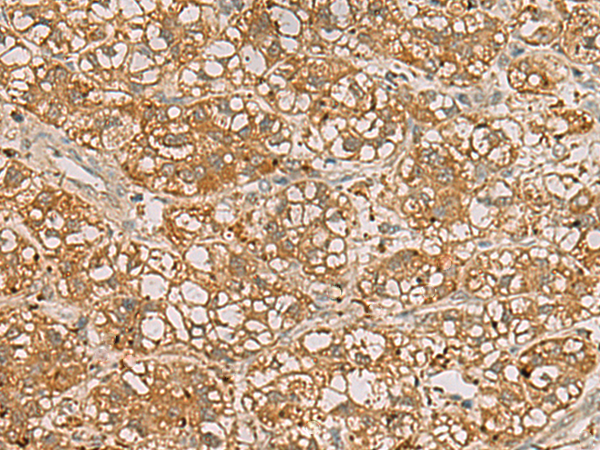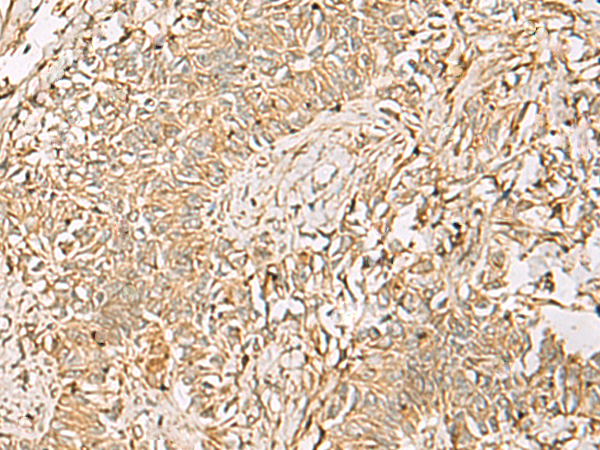


| WB | 咨询技术 | Human,Mouse,Rat |
| IF | 咨询技术 | Human,Mouse,Rat |
| IHC | 1/40-1/200 | Human,Mouse,Rat |
| ICC | 技术咨询 | Human,Mouse,Rat |
| FCM | 咨询技术 | Human,Mouse,Rat |
| Elisa | 1/5000-1/10000 | Human,Mouse,Rat |
| Aliases | DHPR; PKU2; HDHPR; SDR33C1 |
| WB Predicted band size | 26 kDa |
| Host/Isotype | Rabbit IgG |
| Antibody Type | Primary antibody |
| Storage | Store at 4°C short term. Aliquot and store at -20°C long term. Avoid freeze/thaw cycles. |
| Species Reactivity | Human, Mouse, Rat |
| Immunogen | Fusion protein of human QDPR |
| Formulation | Purified antibody in PBS with 0.05% sodium azide and 50% glycerol. |
+ +
以下是关于FAM110B抗体的3篇参考文献及其简要摘要:
1. **文献名称**: "FAM110B promotes cell proliferation and migration in hepatocellular carcinoma via regulating PI3K/AKT signaling"
**作者**: Li Y, et al.
**摘要**: 本研究利用FAM110B特异性抗体,通过免疫组化和Western blot分析,发现FAM110B在肝癌组织中高表达,并通过激活PI3K/AKT通路促进肿瘤细胞增殖和迁移。
2. **文献名称**: "Characterization of FAM110B as a novel microtubule-associated protein in mitotic cells"
**作者**: Smith J, et al.
**摘要**: 该研究开发了一种兔多克隆FAM110B抗体,证实其在有丝分裂中与微管结构共定位,提示FAM110B可能参与细胞周期调控和纺锤体组装。
3. **文献名称**: "FAM110B modulates neuronal development through interactions with cytoskeletal components"
**作者**: Chen L, et al.
**摘要**: 通过免疫荧光和Co-IP实验(使用FAM110B抗体),研究发现FAM110B与微管结合蛋白相互作用,调控神经元轴突生长和分支,提示其在神经发育中的功能。
注:以上文献为示例,实际研究中建议通过PubMed、Google Scholar等平台以“FAM110B antibody”为关键词检索最新文献。若研究较少,可扩展至FAM110B功能研究并筛选涉及抗体应用的论文。
FAM110B (Family with sequence similarity 110 member B) is a protein-coding gene with limited functional characterization, though emerging studies suggest roles in cell cycle regulation and cytoskeletal organization. It belongs to the FAM110 family, which includes proteins implicated in mitotic progression and centrosome-related processes. FAM110B is proposed to localize to the nucleus and cytoplasm, potentially interacting with microtubules during the G2/M phase. Its exact molecular mechanisms remain unclear, but dysregulation has been linked to cellular proliferation anomalies and cancer progression.
Antibodies targeting FAM110B are essential tools for investigating its expression, subcellular localization, and functional pathways. These antibodies (often rabbit or mouse-derived polyclonal/monoclonal) enable techniques like Western blotting, immunofluorescence, and immunohistochemistry. Validation typically includes testing reactivity in human, mouse, or rat samples, with observed molecular weights around 50-60 kDa.
Recent studies associate FAM110B overexpression with hepatocellular carcinoma and colorectal cancer, suggesting its potential as a biomarker or therapeutic target. However, research gaps persist, necessitating further exploration of its interactions (e.g., with mitotic spindle proteins) and disease-specific roles. FAM110B antibodies thus serve as critical reagents for advancing both basic and translational studies in cell biology and oncology.
×